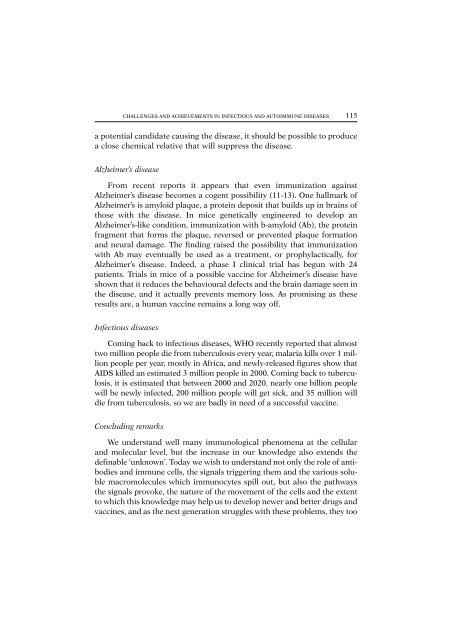Cover BUONA - Pontifical Academy of Sciences
Cover BUONA - Pontifical Academy of Sciences
Cover BUONA - Pontifical Academy of Sciences
You also want an ePaper? Increase the reach of your titles
YUMPU automatically turns print PDFs into web optimized ePapers that Google loves.
CHALLENGES AND ACHIEVEMENTS IN INFECTIOUS AND AUTOIMMUNE DISEASES 115<br />
a potential candidate causing the disease, it should be possible to produce<br />
a close chemical relative that will suppress the disease.<br />
Alzheimer’s disease<br />
From recent reports it appears that even immunization against<br />
Alzheimer’s disease becomes a cogent possibility (11-13). One hallmark <strong>of</strong><br />
Alzheimer’s is amyloid plaque, a protein deposit that builds up in brains <strong>of</strong><br />
those with the disease. In mice genetically engineered to develop an<br />
Alzheimer’s-like condition, immunization with b-amyloid (Ab), the protein<br />
fragment that forms the plaque, reversed or prevented plaque formation<br />
and neural damage. The finding raised the possibility that immunization<br />
with Ab may eventually be used as a treatment, or prophylactically, for<br />
Alzheimer’s disease. Indeed, a phase I clinical trial has begun with 24<br />
patients. Trials in mice <strong>of</strong> a possible vaccine for Alzheimer’s disease have<br />
shown that it reduces the behavioural defects and the brain damage seen in<br />
the disease, and it actually prevents memory loss. As promising as these<br />
results are, a human vaccine remains a long way <strong>of</strong>f.<br />
Infectious diseases<br />
Coming back to infectious diseases, WHO recently reported that almost<br />
two million people die from tuberculosis every year, malaria kills over 1 million<br />
people per year, mostly in Africa, and newly-released figures show that<br />
AIDS killed an estimated 3 million people in 2000. Coming back to tuberculosis,<br />
it is estimated that between 2000 and 2020, nearly one billion people<br />
will be newly infected, 200 million people will get sick, and 35 million will<br />
die from tuberculosis, so we are badly in need <strong>of</strong> a successful vaccine.<br />
Concluding remarks<br />
We understand well many immunological phenomena at the cellular<br />
and molecular level, but the increase in our knowledge also extends the<br />
definable ‘unknown’. Today we wish to understand not only the role <strong>of</strong> antibodies<br />
and immune cells, the signals triggering them and the various soluble<br />
macromolecules which immunocytes spill out, but also the pathways<br />
the signals provoke, the nature <strong>of</strong> the movement <strong>of</strong> the cells and the extent<br />
to which this knowledge may help us to develop newer and better drugs and<br />
vaccines, and as the next generation struggles with these problems, they too
















